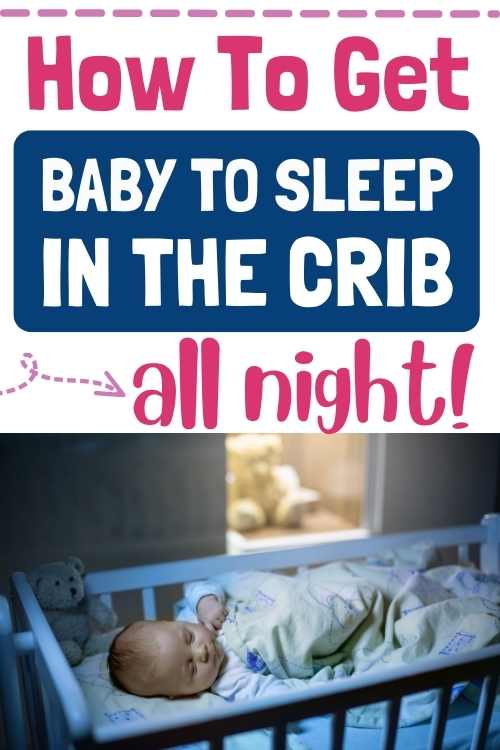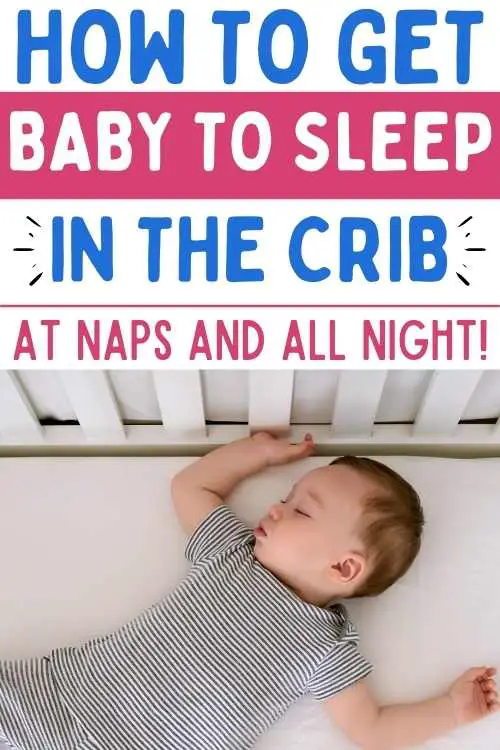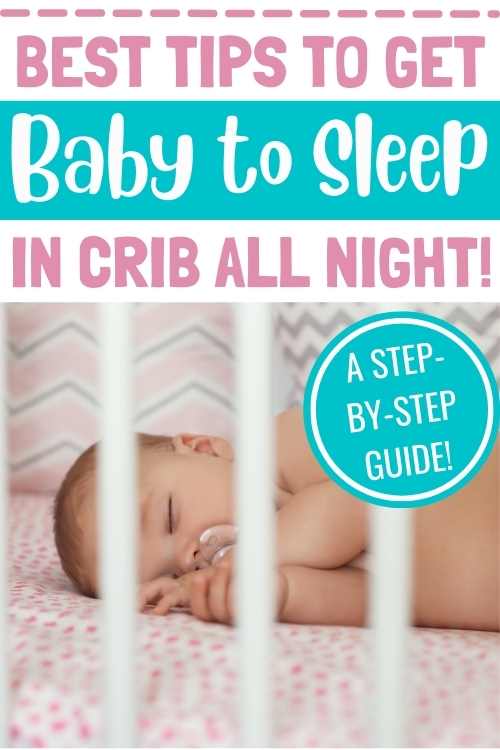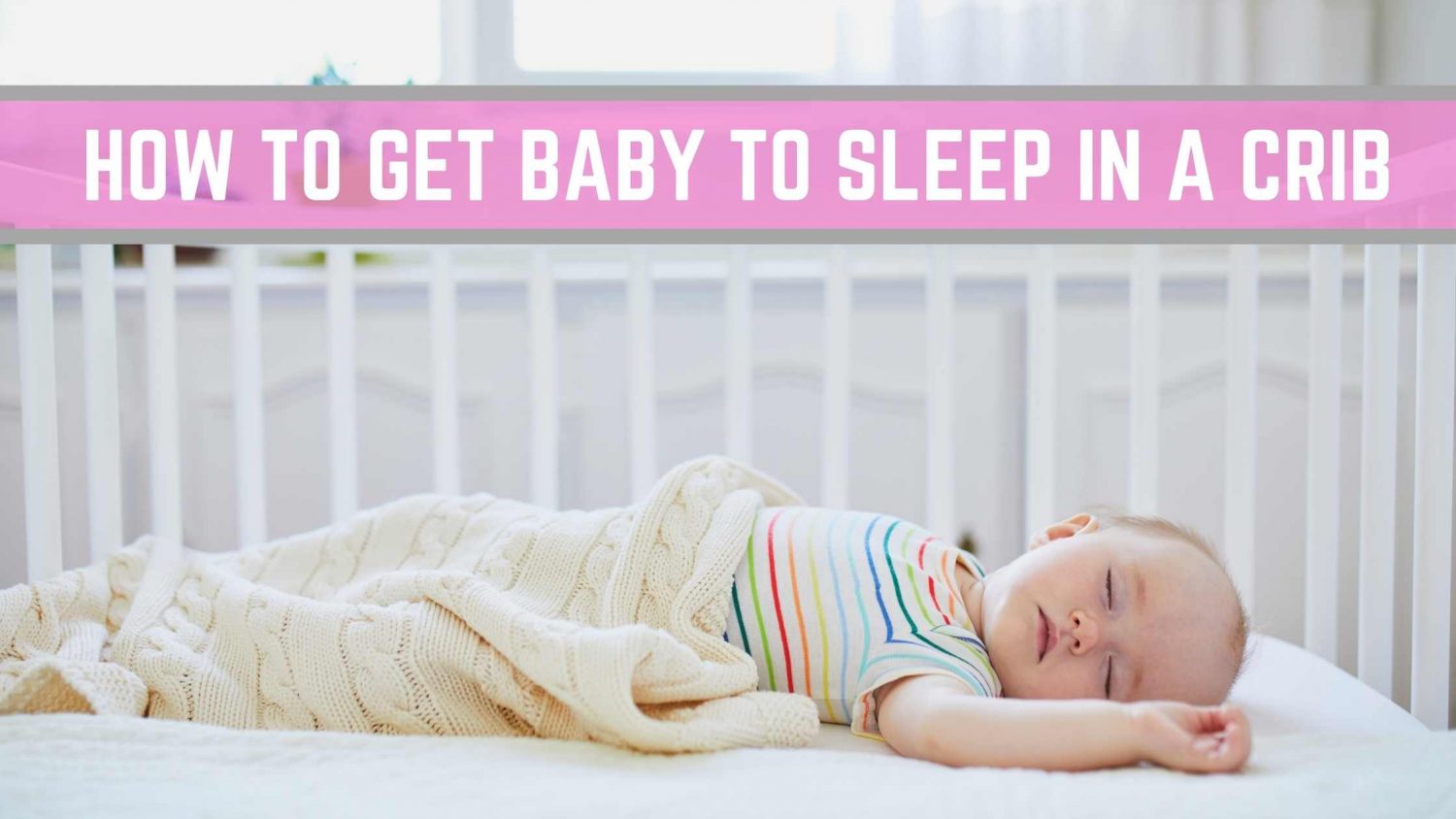If there is one thing babies, especially newborn ones, are great at (aside from being pooping and insanely cute), is sleeping. They can flake out in a car, on a stroll, during their feeding, or in your arms – virtually everywhere it seems.
But why is it so hard to hush a baby to sleep in a crib hoping that they can sleep properly sometimes? Indeed, how to get a baby to sleep in a crib is a common riddle with most parents.
So, let’s dive into the content below to unclog this tricky riddle together now.
Related:

Why won’t my Baby Sleep in the Crib?
First thing first, below are the main reasons why your baby might not like to fall asleep in a crib.
1) Environment
If the area in which your crib is put is not promoting sleep, then your child isn’t being offered the right chance to take the rest that they need!
The room should be completely dark or without distraction and it shouldn’t not let unexpected noises or outside sound in – at night as well as during their daily naps. Also, it needs to be set up at the optimum temperature ranging between 18 and 21 °C (65-72 °F) for your little one to feel comfortable and safe.
If your baby is waking up because they are too cold or too hot, make sure you are using a summer or winter sleeping bag (so they don’t kick off any blanket) and that the sleeping bag is of the right TOG rating.
Keep in mind that even when your kid can nod off in a shopping cart at the supermarket, that doesn’t equate to that place being a good one for your baby’s sleep. Our task is to bring the optimal sleeping condition for them at home.
Related:
2) Habit
Before your baby was born, they spent over nine months staying in your warm dark belly, surrounded by fluid. So it’s not surprising that they are not too happy to stay on a sturdy mattress in the crib.
This explains why it’s so vital to help recreate those matrix feelings with dark environments and swaddling. But also, it is the reason why it’s essential to assist your kid is getting used to the crib by settling them there at any nap.
This repetition will help them become much more familiar with the place for sleep and, when they learn there is no other choice, they will adapt accordingly.
3) Time of Placing Baby in the Crib
When you put your child in the crib, observe carefully how they react. For instance, if they are fussy or overtired, they could cry and even scream, but it doesn’t necessarily mean they don’t like the crib – it just means they are overtired and can’t fall asleep.
It’s crucial to catch up with the proper awake schedules of your kid’s age to determine whether you are not placing them down too late or too early. If you wish, there are some very good sample feeding and sleeping baby schedules here, sorted by age.

How to Get A Baby To Sleep In A Crib
Once you’ve identified and addressed the reasons why your baby might not like the crib, you can follow the steps below on how to teach your child to happily drift off in one.
Newborn (0-4 Months)
Step 1. Observe Your Kid’s Sleep Signs
Like I mentioned above, every baby has different awake times, subject to their age. Newborns often stay awake for around 45 minutes to one hour for example. Therefore, it is great to know those awake time schedules so you can understand when your newborn is willing to sleep.
Also, it is crucial to follow an infant’s sleep hints, such as: slower motions, rubbing eyes, yawning, or appearing indifferent while playing with toys. When you notice some of the above signs, you can confirm that it is time for your baby to go to sleep and move on to the second step.
Step 2: Set Up a Good Relaxing Routine
A good and relaxing bedtime routine is extremely important in any sleep training method and also applies to getting your baby to sleep in a crib.
This routine might only last around 5 to 10 minutes (particularly for infants, who don’t require much time to fall asleep) or a little longer if your baby isn’t calming down. The rule of thumb is to maintain this routine and be consistent.
Please don’t drop this step after only a few times: as time passes, your newborn will learn that after the relaxing routine, sleep timing is coming.
The routine could be created by anything that makes your newborn calm down and completely ready to sleep. Below are some instances of great calming routines that you can try with your baby:
- Hold your infant in your arms for a moment and stroll around in the room
- Sing nursery rhymes
- Close the curtains or blinds
- Swaddle them to keep them warm (or if you don’t have a swaddle, click here for alternatives).
- Turning on an infant soother light
- Have a bath
- Turn on a white nose machine
Step 3. Put your Newborn in the Crib Awake
We all know it is better said than done, yet it’s completely possible. And you might want to follow this particular step when your baby is between 3 and 4 months of age (don’t worry to much about this when your baby is younger than that – you can rock them and put them down asleep when they are so little).
A baby younger than 4-6 months old is still young enough not to be too aware of sleep associations such as shushing or rocking to sleep: they will not need or want them so desperately to scream for them for too long. On the other hand, when the baby reaches the 6 months old mark, they will become way more aware and extremely hard to settle if you don’t give them what soothes them to go to sleep.
You might even notice that your baby goes through a sleep regression at 4 months old and keeps waking up at night because they don’t know how to back to sleep by themselves. So you really want to teach them how to “self settle” as soon as possible – meaning they will learn how to go to sleep (before bedtime and in-between sleep cycles) by themselves without the help of an adult.
There are various gentle sleep training methods (that don’t involve cry-it-out) that you can try, depending on how your child reacts to the news of being put down by themselves. I am not a strong believer in one method being better than the others, but it really depends on your child (and how you react!).
Have a look here at what these methods are and find out the one that would best suit you and your baby, and check out other tips for when to actually start sleep training.

Older Baby (Over 4 Months)
Step 1 and 2 for older babies are pretty similar to the ones for newborns and younger babies. However, when your child is older than 4-6 months, they need more quiet time before they go to sleep, to be able to relax and wind down. While infants might need around an hour, a six-month-old kid might play around for 2.5 hours before they are ready to sleep.
As such, a relaxing bedtime routine is even so more important. Reading bedtime stories in particular works very well for most kids, bringing a lot of benefits.
Step 3, on the other hand, becomes a bit different, because of the difference in your baby’s awareness at this age (as explained above), and other development milestones your baby is going through, which may also lead to the 6 month sleep regression.
There are lots of tips here on how to settle your baby to sleep around 6 months, and the sleep training methods listed here are all still valid. However, what I would highly recommend at this stage for your baby to fall asleep in a crib is the introduction of a lovey – a transitional item that your baby can have while sleeping. This could be a security blanket, a stuffed toy, or a small washcloth.
Offer it to your kid only when it is time to go to sleep and they sill soon associate it to sleep time. Don’t overlook the lovey’s importance!
4 Other Useful Tips to Try
Below are some other tips that you can try to help your baby fall asleep in a crib.
1) Start Early
Habit becomes stronger over time and thus more difficult to break. It is better to set up a preferred sleep routine as early as four to eight weeks, so begin working on short naps in a crib then to get your baby used to it.
For example, I started putting my second baby to sleep in the crib during the day when she was around 2 months old and she was still sleeping with me in the co-sleeper at night. This way, she was already familiar with the crib when I transitioned her there at night later on.
2) Use a White Noise Machine
A white noise machine will create a comfortable environment that calms the baby, helping them to fall asleep faster. It is also great to cover up the noise of the toddler running around the house when the baby is sleeping. You know what I mean if you have a toddler and a baby at home!
I use the Hushh Portable White Noise Machine, which is awesome. I can also take it with me in the car or in the stroller.
3) Consider a Baby Swaddle
It is so easy to wake your little baby up when you put them down in the crib – they startle and wake themselves up the moment you lay them down. To reduce the chance of this happening, try using a swaddle or a sleeping bag. This can even help if your baby keeps getting stuck on the side of the crib.
There’s lots of information on how to dress your baby to sleep here but, in general, a swaddle is recommended until your baby starts to roll, then you can transition to a sleeping sack or sleeping back. A sleeping back is actually the safest option for babies until they are old enough to put their blanket on or take it off by themselves.
Related:
- 10 Best Baby Sleep Sacks for Summer (0.5 & 1 TOG)
- 8 Best Baby Sleep Sacks for Winter (2.5 & 3.5 TOG)
4) Try Sleep Training
If you are exhausted, sleep deprived, and struggling with baby sleeping, and none of the information above seems to help, I would really recommend looking at sleep training and getting the professional help of a sleep consultant. The older the babies get the harder sleep training becomes, so it’s good to address bad sleeping habits sooner rather than later. I learned this lesson the hard way with my first daughter!
I have put together a list of gentle sleep training methods that involve little to no crying if you want to have a look. There are also some programs that offer FREE resources.
However, if your baby seems to be suffering from separation anxiety when you leave them in the crib and starts crying as soon as you leave the room, you should definitely try the Chair or Sleep Lady Shuffle Sleep Training Method.
Related:
- 8 Tips for New Parents to Avoid Sleep Deprivation
- 6 Sleep Training Methods that ACTUALLY work (and that don’t involve Cry It Out!)

When to Start Using a Crib
When to start using a crib really depends on you and what you want for your baby. Some parents prefer to have their newborn in a bassinet / co-sleeper for a while after birth, whereas others like to have their child sleeping in the crib from birth. It’s almost like two different philosophies out there.
I personally put my first daughter in the crib when she wasn’t even 1 month old, but kept my second one in the co-sleeper for as long as I could and only moved her to the crib when she was almost 3 months. And the main reason for this is that my first daughter was bottle-fed and didn’t seem to mind sleeping in the crib from a very young age, whereas my oldest was breastfed and I just found the logistics of feeding her at night to be so much easier if she was sleeping right next to me (you might be interested in reading our article on combination feeding and pumping schedules to help with this).
That said, most parents transition their child to a crib when they are 3-4 months. If your child is really enjoying the bassinet, you might not want to rush the transition, but remember that the more you wait, the harder is going to become for your child to get accustomed to the new sleep environment.
Of course, once your baby can sit up (usually around 6 months), most bassinets or co-sleepers will become unsafe for your child as they can easly fall off from the sides. For their safety, your baby should definitely be sleeping in a crib before then.
When to Stop Using a Crib
Other than the fact that it becomes unsafe for your kid to keep sleeping in the crib when they can climb out of it, there’s no real hard rule on when to transition your baby from the crib to a bed.
If your baby is still safe in it and sleeps well through the night, I would actually delay the transition to a bed for as long as possible. Some studies actually suggest it is better to delay the transition to when your child is closer to 3 years old to avoid your toddler regularly getting out of bed and coming to your room at night, which could disrupt sleep for both of you.
In general, most parents will stop using a crib between 18 months old and 36 months old.
How to Get a Baby to Sleep in a Crib: Final Thoughts
Here it is mom – I hope I have answered your question on how to get a baby to sleep in a crib and given you some extra tips on how to get your baby to fall asleep independently.
There’s nothing harder or more exhausting than losing hours of sleep once your baby is born. My first daughter didn’t sleep through the night until she was 4 years old, so I know all about sleep deprivation and I understand your worries and anxieties about transitioning your baby to a crib.
But don’t worry mama – you got this! And if you need any more help, don’t hesitate to get in touch!
For more tips and information on sleep training and sleep regressions:
- 4 Month Sleep Regression (why it is the most important one to get right!)
- 6 Month Sleep Regression: Tips on How to Tackle it Fast
- The 8, 9 or 10 Month Sleep Regression: Signs and Tips on How to Survive it
- Baby Waking Up Multiple Times a Night: here’s what you need to know
- 6 Sleep Training Methods (with Little to No Crying!)
Did you find this helpful? Pin It!


